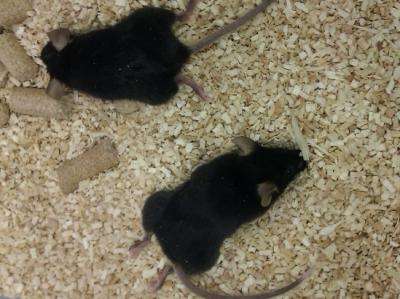Researchers generate mutant mouse model useful in treatment of neuromuscular diseases

Researchers at the University of Granada have produced for the first time in the world mice lacking the coenzyme Q10, a rare mitochondrial disease prevailingly affecting children. The researchers needed three years to complete the study.
In three to six months of life, this genetic alteration in mice –similar to that occurred in human– causes a rapid degeneration in the lower limbs to death for cardiac arrest.
For the first time in the world, researchers at the Center for Biomedical Research of the University of Granada have created mice with a genetic mutation inducing a deficiency in the coenzyme Q10, a rare mitochondrial disease prevailingly affecting children. These mutant mice –which lack the Coq9 gene– will be "a valuable tool for the study and treatment of metabolic encephalopathies and neuromuscular diseases", the researchers state.
Coenzyme Q10 (CoQ10) is a molecule produced in body cells, which functions are crucial to cell metabolism. Their best-known function is their generating energy used by cells and their antioxidant activity. In human, defects in the biosynthetic route cause CoQ10 deficiency, resulting in a syndrome with very heterogeneous symptoms.
To better understand the pathological mechanisms of this disease and learn about the biosynthetic pathway of CoQ, the University of Granada researchers conducted a three-year study to generate mice with a mutation in a gene (Coq9) similar to that found in humans. This gene codifies a protein involved in CoQ biosynthesis.
Lower Limb Paralysis
Accordikng to professor Luis Carlos López García –the principal investigator of this study– states, "mice with a Coq9 mutation develop a severe encephalomyopathy inducing neural death, astrogliosis and vacuolation of the brain. At three to six months, these mice undergo a rapid degeneration causing lower limp paralysis and death for cardiac arrest. In molecular terms, CoQ deficiency in mice impairs the mitochondrial mechanisms of bioenergy production in the brain, causing a severe bioenergetic deficiency and a slight increase in oxidative damage".
The CoQ9-deficient mutant mouse model generated at the University of Granada "is the first model of CoQ9-deficient mutant mice with mitochondrial encephalomyopathy created worldwide. Currently, there is not any therapy for neuromuscular diseases associated with CoQ10 deficiency, and this mutant model might be useful in the development of an effective therapy for such diseases. In addition, as CoQ10 is also used as a nutritional supplement and in the cosmetics industry, "the CoQ9-deficient mutant mouse model is very useful in the assessment of the effectiveness of nutritional supplements and cosmetics".
The results of this research study –which received financial support from CEI BioTic Granad, the Spanish Ministry of Economy and Competitiveness, the Andalusian Regional Government and the Marie Curie program– have been recently published in the prestigious journal Human Molecular Genetics. Researchers from the National Cardiovascular Research Center (CNIC) also participated in the study.
More information: García-Corzo L, Luna-Sánchez M, Doerrier C, García JA, Guarás A, Acín-Pérez R, Bullejos-Peregrín J, López A, Escames G, Enríquez JA, Acuña-Castroviejo D and López LC. Dysfunctional Coq9 Protein Causes Predominant Encephalomyopathy Associated to CoQ Deficiency. Human Molecular Genetics, in press.DOI: 10.1093/hmg/dds530















